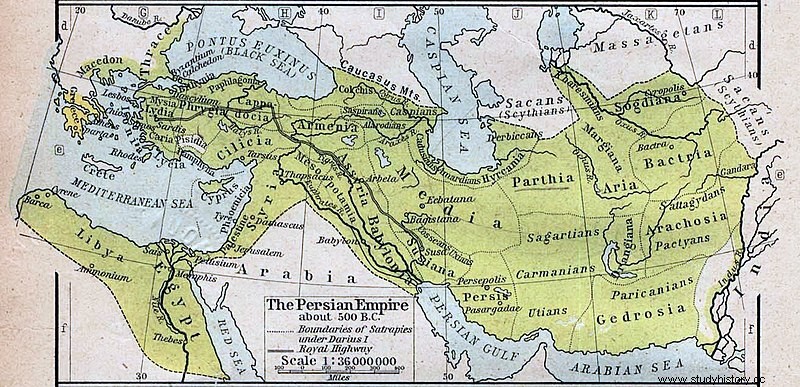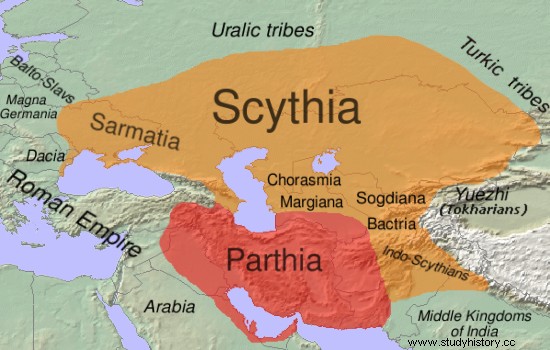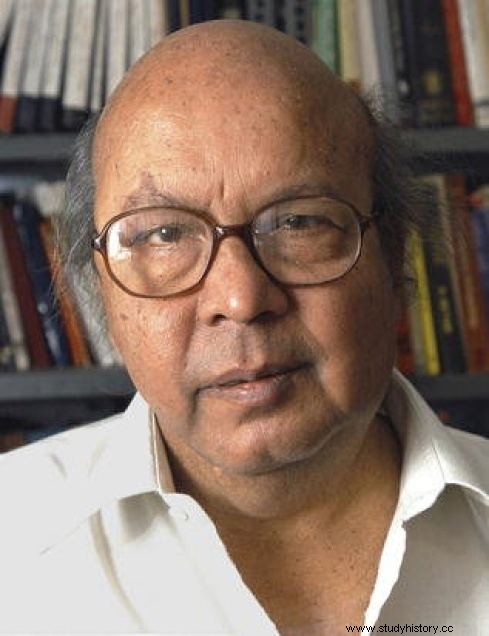According to western historians, settled on a handful of islands and a small European kingdom, Greek and Rome had only developed civilization, there was Greek, Roman Empire and there were emperors, all the rest were barbaric, nomad, clan ( tribe) and the chieftain of the clan.
Some examples of how rude, nomadic, clan and clan chieftains were in the eyes of Western historians:The Achamanid Empire of Iran in the 6th century AD, which, in the words of these historians, ranged from Central Asia to Turkey, Egypt. and extended to Greece; But, the Akhamani people who made up that great empire that spanned three continents were rude, nomadic, tribal and only chieftains of the tribe.

The Sakas, who defeated the Akhamanians by killing the great emperor of such a large Akhamani Empire, Kurus/Kurav (Cyrus) in battle, on whose name the whole of Central Asia was called Shakal Island or Saka Island in ancient times and according to these historians Scythia These doubts were inhabited, those doubts were also rude, nomadic, tribal and chieftains of the tribe in their eyes. Similarly, the Kushan/Tushars who established the empire from Uzbekistan to Mathura and the Hindu-Buddhist Turks who ruled Central and Middle-East Asia were also uncivilized, nomadic, tribal and tribal chieftains.

I have not given the example of the vast empires of India so that the people educated / educated by the Macaulay-Left method should not waste their time by fuming and further pay attention to the details and evidences related to the kings, emperors and their empires given in the Rigveda. able.
The reason for the petty mentality of western historians
There are two reasons for the petty and perverted mentality of Western historians - first, their creation of the Christian faith was created according to the Bible only before 4004 AD. Therefore it was difficult for them religiously and mentally to believe that India had a well-developed civilization thousands of years ago, had great empires and emperors, reached a high level in knowledge, science, astrology, philosophy, mathematics, warfare etc. were, etc.
The second reason for the narrow mentality of Western historians is their illusion that civilization, development, knowledge, science, philosophy, monarchy, democracy etc. are all after the coming of Jesus Christ and the result of Christianity. In this illusion, they have forgotten their European history of BC by calling them the Dark Ages. Even the misfortunes of the wise men like Socrates, Galileo, Giudarno Bruno, Jesus Christ etc. have not been able to free him from the illusion. If they also do truthful research on what was the source of intellectual knowledge due to which intellectual disagreement was caused to them, then they might get rid of confusion and change their attitude towards India.
And the people who are educated / educated by the Macaulay-waist method, who are confused on our point, they must take the trouble of reading the history of Europe before the fourteenth century. Further in this article, we are presenting the evidence of ancient states, kings, emperors and empires of India from Rigveda only.
Many types of kings mentioned in Rigveda
On the one hand, the official scholars working on Vedic literature have been unanimous in this matter that there was monarchy in the Vedic period, on the other hand, some other scholars have been selected for their own purpose from the works and translations and interpretations of these scholars. On the analogy, the Vedic king has been proved to be the chieftain of the clan.
No matter how uncertain these scholars may be about the nature of the state, there is no doubt about its existence because the king who has been used more than 100 times in the Rigveda to indicate the existence of state power, Bhuvah Samrat or Found many words like Bhupati (4.19.2), Ekrat (8.37.3), Adhirat (10.128.9), Virat (1.18.4-6), Swarat (1.61.9) etc. From which it appears that there was a solid physical basis for the imagination of small states to large states. Where comparatively small and large states and positions of many sizes are mentioned, then it cannot be dealt with in such a superficial manner.
Apart from this, Raja of Bhuvan (5.85.3), Lokhitkari Raja (3.55.2) in Rigveda. King of earthly wealth (2.14.11), the only king of the whole world (3.46.2), king of all people (1.59.5; 6.22.9; 7.27.3) mountain , river, place, the king of all (1.59.3), the king born in the Ritjaat or high clan (9.108.8) etc. details are found. (Harappan Civilization and Vedic Literature, author-Bhagwan Singh, pp. 200–203)
Various administrative posts mentioned in Rigveda
The Rigveda does not only refer to these different types of states, but Amatya (7.15.3), Senani (7.20.5), Advocate (2.23.8), Upvakta (4.9.5) ), messengers (3.3.2), char or spasha (4.4.3) etc. are also found, which give irrefutable confirmation that an orderly monarchy and hierarchy existed during this period. On the other hand Gramani (10.62.11), Vishapati (2.1.8), Naya (hero?) (6.24.10), Neta (3.6.5), Ganapati (2.23.1) The use of primordial words refers to an organized rural administration (Which, p. 201). Everyone will be familiar with the words like Sabha, Samiti and their meaning and role used in Rigveda.
Properties of Vedic kings in Rigveda
The king should have a vast territory and authority over it (7.27.3). For the governance of this vast area it is necessary that he should be aware of it, be learned and considerate (9.97.56). His upbringing, nurturing and education etc. must be done properly, he should be born in the royal family (9.108.8). He should not be subordinate to anyone (6.7.7), take leadership in times of war (2.9.6). Let all people accept his submission and bow down to him (2.9.6). He should be generous and follow the rules himself (2.1.4).
It is necessary for the king to expand the kingdom by conquering the enemies or by subjugating them and collecting taxes and keeping the treasury full (4.50.9). He should do justice fairly and punish those who break the rules (1.24.15). The king was given a unique dress (1.25.13), splendor (8.21.18), residence (2.41.5; 3.1.18; 7.88.5), high seat (31/12.8) .3.4) and the well-equipped chariot (2.18.4-6; 6.29.2) should be the owner.
Keeping these various qualifications in mind, you will find that the expectations that have been made from the kings of the Vedic period, the picture prepared of them is not at all different from the kings of the historical times. The king having a huge army, with his power (Pratap) burns the enemies like a scorching sun-Tapanti Shatrum Swah Na Bhuma Mahasenasah Amebhi:Esham (7.34.19), which also removes the remaining fears. (Same, pages 203-204)
Ridiculous wisdom of leftist historians

Historian Dwijendranath Jha, in an interview to the BBC, says that from the fifth century to the sixth century, small states began to be formed and the practice of donating land started. For this reason the importance of animals for agriculture increased. Especially the importance of cow also increased. After that it started mentioning in the scriptures that the cow should not be killed.”
Now see, according to Indian historical texts, the invention of agriculture and the beginning of agricultural work was done by Ichchhavaku Vanshi Maharaj Prithu, whose empire was called earth, due to which the most popular word for the whole earth is still the earth. Well, due to being a leftist, he was unable to see that far, but everyone knows that before 500 AD, there was an empire of Haryanka dynasty in which Bimbisara and Ajatashatru were two emperors. Then Ghanananda was the emperor of the vast Magadha Empire.
After that, the empire of Chandragupta Maurya was in 300 AD, according to these historians, from Afghanistan, Pakistan in the north to Kashmir in the north, Narmada in the south and most parts of the Bengal region in the east. Later Ashoka expanded that empire further. Then how ridiculous it is to say that small kingdoms began to form in the fifth-sixth century! The saga of Chakrabarti emperor Vikramaditya was sung even in the Arab country, the evidence of which is still preserved in books, copper and gold papers and in museums. Were all these small states?
The reality is that leftist historians, who believe the misguided knowledge of Christian English historians to be supernatural knowledge and write agenda history for vested interests, have become victims of intellectual bankruptcy. That is why Romila Thapar says that Yudhishthira of Mahabharata had received education from Emperor Ashoka. Perhaps that is why the imperialist, leftist historians consider the 'tax' collected by the Rigvedic kings, emperors and the 'bali' (offering) given to them as 'plunder'.
